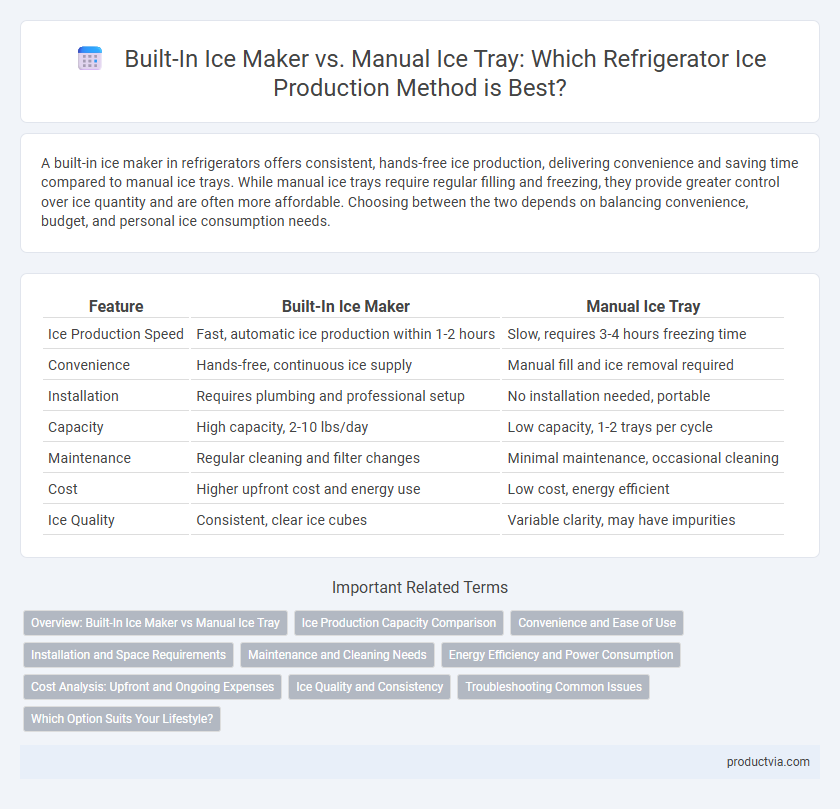A built-in ice maker in refrigerators offers consistent, hands-free ice production, delivering convenience and saving time compared to manual ice trays. While manual ice trays require regular filling and freezing, they provide greater control over ice quantity and are often more affordable. Choosing between the two depends on balancing convenience, budget, and personal ice consumption needs.
Table of Comparison
| Feature | Built-In Ice Maker | Manual Ice Tray |
|---|---|---|
| Ice Production Speed | Fast, automatic ice production within 1-2 hours | Slow, requires 3-4 hours freezing time |
| Convenience | Hands-free, continuous ice supply | Manual fill and ice removal required |
| Installation | Requires plumbing and professional setup | No installation needed, portable |
| Capacity | High capacity, 2-10 lbs/day | Low capacity, 1-2 trays per cycle |
| Maintenance | Regular cleaning and filter changes | Minimal maintenance, occasional cleaning |
| Cost | Higher upfront cost and energy use | Low cost, energy efficient |
| Ice Quality | Consistent, clear ice cubes | Variable clarity, may have impurities |
Overview: Built-In Ice Maker vs Manual Ice Tray
Built-in ice makers offer automated ice production with consistent output, ideal for frequent use and convenience, while manual ice trays require user effort to fill and freeze water, providing a cost-effective and simple solution. Built-in units typically produce larger quantities of ice quickly, often integrated with the refrigerator's water line, whereas manual trays depend on freezer cycles and are limited by size and shape. Choosing between the two depends on household ice demands, space availability, and budget considerations.
Ice Production Capacity Comparison
Built-in ice makers typically produce between 3 to 10 pounds of ice per day, offering consistent and automatic ice production ideal for households with higher demand. Manual ice trays, however, yield approximately 1 to 2 pounds of ice per freeze cycle, requiring manual refilling and longer wait times. Choosing between the two depends largely on desired daily ice output and convenience preferences.
Convenience and Ease of Use
Built-in ice makers offer seamless convenience by automatically producing ice without manual effort, ensuring a continuous supply with minimal maintenance. Manual ice trays require regular filling, freezing, and unloading, which can be time-consuming and less efficient for frequent ice needs. For users prioritizing ease of use, built-in ice makers deliver consistent ice production with effortless operation compared to the hands-on process of manual trays.
Installation and Space Requirements
Built-in ice makers require professional installation and dedicated plumbing connections, which can limit placement flexibility but provide a continuous supply of ice without manual effort. Manual ice trays offer greater versatility in positioning since they need no plumbing or electrical setup, but they require freezer space and regular refilling to maintain ice production. Space considerations favor manual trays in compact freezers, whereas built-in ice makers occupy internal compartments that reduce overall storage capacity but enhance convenience.
Maintenance and Cleaning Needs
Built-in ice makers require regular cleaning of water lines and internal components to prevent mold and mineral buildup, often needing professional servicing for thorough maintenance. Manual ice trays are easier to clean, requiring simple washing and drying, but they need frequent refilling and scrubbing to avoid bacteria growth. Choosing between the two depends on balancing convenience with maintenance effort, where built-in units offer automated production but higher upkeep, while trays offer simplicity but require manual labor.
Energy Efficiency and Power Consumption
Built-in ice makers in refrigerators typically consume more energy due to their continuous operation and internal water dispensing mechanisms, which require consistent power supply. Manual ice trays, being non-electric, offer superior energy efficiency as they rely solely on the freezer's cooling system without additional power usage. Choosing manual ice trays can significantly reduce overall refrigerator power consumption, making them an eco-friendlier option for ice production.
Cost Analysis: Upfront and Ongoing Expenses
Built-in ice makers typically involve higher upfront costs due to installation and appliance price, while manual ice trays are inexpensive and require no installation. Ongoing expenses for built-in ice makers include increased water and electricity usage, whereas manual trays have negligible operational costs. Evaluating these costs helps determine the most budget-friendly option based on long-term ice production needs.
Ice Quality and Consistency
Built-in ice makers produce uniform, clear ice cubes with consistent size and shape, enhancing beverage presentation and cooling efficiency. Manual ice trays often result in irregular, cloudy ice due to trapped air and impurities, affecting both aesthetics and melt rate. The automated freezing cycle of built-in ice makers ensures reliable ice quality and supply, outperforming the variability of manual trays.
Troubleshooting Common Issues
Built-in ice makers often face issues like ice jams, sensor malfunctions, or water supply problems requiring regular cleaning and ensuring adequate water pressure. Manual ice trays commonly encounter difficulties such as uneven freezing or cracking, which can be alleviated by using high-quality, flexible trays and avoiding rapid temperature changes. Both systems benefit from routine maintenance and prompt attention to any leaks or mechanical faults for optimal ice production.
Which Option Suits Your Lifestyle?
Built-in ice makers provide continuous, effortless ice production ideal for households with frequent entertaining or heavy ice consumption, ensuring convenience and consistent supply. Manual ice trays require minimal installation and perfect for smaller families or infrequent ice use, offering a cost-effective and space-saving solution. Choosing between these options depends on lifestyle factors such as usage frequency, kitchen space, and budget priorities.
Built-In Ice Maker vs Manual Ice Tray for Ice Production Infographic

 productvia.com
productvia.com